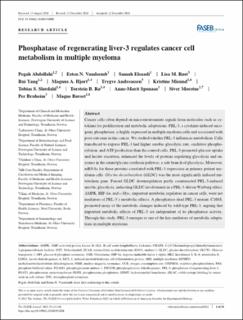| dc.contributor.author | Abdollahi, Pegah | |
| dc.contributor.author | Vandsemb, Esten | |
| dc.contributor.author | Elsaadi, Samah | |
| dc.contributor.author | Røst, Lisa Marie | |
| dc.contributor.author | Yang, Rui | |
| dc.contributor.author | Hjort, Magnus Aassved | |
| dc.contributor.author | Andreassen, Trygve | |
| dc.contributor.author | Misund, Kristine | |
| dc.contributor.author | Slørdahl, Tobias Schmidt | |
| dc.contributor.author | Rø, Torstein Baade | |
| dc.contributor.author | Sponaas, Anne-Marit | |
| dc.contributor.author | Moestue, Siver Andreas | |
| dc.contributor.author | Bruheim, Per | |
| dc.contributor.author | Børset, Magne | |
| dc.date.accessioned | 2021-04-06T09:48:41Z | |
| dc.date.available | 2021-04-06T09:48:41Z | |
| dc.date.created | 2021-02-11T08:09:32Z | |
| dc.date.issued | 2021 | |
| dc.identifier.citation | The FASEB Journal. 2021, 35 (3), . | en_US |
| dc.identifier.issn | 0892-6638 | |
| dc.identifier.uri | https://hdl.handle.net/11250/2736333 | |
| dc.description.abstract | Cancer cells often depend on microenvironment signals from molecules such as cytokines for proliferation and metabolic adaptations. PRL‐3, a cytokine‐induced oncogenic phosphatase, is highly expressed in multiple myeloma cells and associated with poor outcome in this cancer. We studied whether PRL‐3 influences metabolism. Cells transduced to express PRL‐3 had higher aerobic glycolytic rate, oxidative phosphorylation, and ATP production than the control cells. PRL‐3 promoted glucose uptake and lactate excretion, enhanced the levels of proteins regulating glycolysis and enzymes in the serine/glycine synthesis pathway, a side branch of glycolysis. Moreover, mRNAs for these proteins correlated with PRL‐3 expression in primary patient myeloma cells. Glycine decarboxylase (GLDC) was the most significantly induced metabolism gene. Forced GLDC downregulation partly counteracted PRL‐3‐induced aerobic glycolysis, indicating GLDC involvement in a PRL‐3‐driven Warburg effect. AMPK, HIF‐1α, and c‐Myc, important metabolic regulators in cancer cells, were not mediators of PRL‐3’s metabolic effects. A phosphatase‐dead PRL‐3 mutant, C104S, promoted many of the metabolic changes induced by wild‐type PRL‐3, arguing that important metabolic effects of PRL‐3 are independent of its phosphatase activity. Through this study, PRL‐3 emerges as one of the key mediators of metabolic adaptations in multiple myeloma. | en_US |
| dc.language.iso | eng | en_US |
| dc.publisher | Wiley Periodicals LLC on behalf of Federation of American Societies for Experimental Biology. | en_US |
| dc.rights | Attribution-NonCommercial-NoDerivatives 4.0 Internasjonal | * |
| dc.rights.uri | http://creativecommons.org/licenses/by-nc-nd/4.0/deed.no | * |
| dc.title | Phosphatase of Regenerating Liver-3 Regulates Cancer Cell Metabolism in Multiple Myeloma | en_US |
| dc.type | Peer reviewed | en_US |
| dc.type | Journal article | en_US |
| dc.description.version | publishedVersion | en_US |
| dc.source.volume | 35 | en_US |
| dc.source.journal | The FASEB Journal | en_US |
| dc.source.issue | 3 | en_US |
| dc.identifier.doi | 10.1096/fj.202001920RR | |
| dc.identifier.cristin | 1888715 | |
| dc.description.localcode | © 2021 The Authors. This is an open access article under the terms of the Creative Commons Attribution‐NonCommercial‐NoDerivs License, which permits use and distribution in any medium, provided the original work is properly cited, the use is non‐commercial and no modifications or adaptations are made. | en_US |
| cristin.ispublished | true | |
| cristin.fulltext | original | |
| cristin.qualitycode | 2 | |

